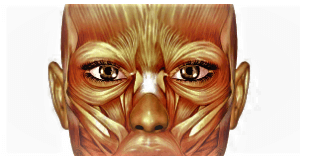Quick Overview
What is Frontalis Muscle? The frontalis muscle is a thin, sheet-like muscle located on the forehead. It originates from the frontal bone and is inserted into the skin of the forehead.
This muscle is responsible for raising the eyebrows and wrinkling of the forehead. It is innervated by the facial nerve and supplied blood by the supraorbital artery and the supratrochlear artery.

| Muscle | Description |
| Origin | Frontal bone |
| Insertion | Skin of the forehead |
| Blood Supply | Supraorbital artery, supratrochlear artery |
| Nerve Supply | Facial nerve |
| Functions | Raises the eyebrows, Wrinkles the forehead |
Table of Contents
Anatomy
The frontalis muscle is a paired muscle, which means that there is one on each side of the forehead. The two muscles are joined together through a fibrous band called the epicranial aponeurosis.
It is also attached to the occipital bone at the back of the head by the occipitalis muscle. It is primarily composed of skeletal muscle fibers.
Location
The frontalis muscle is located on the forehead, just above the eyes. It extends from the hairline down to the eyebrows.
Functions
1- Facial Expression: The most common function of this muscle is raising the eyebrows. When you’re surprised, intrigued, or trying to express curiosity, the Frontalis muscle goes to work, lifting your brows and creating a distinctive look.
2- Forehead Movement: It also enables the skin of the forehead to move, allowing for wrinkling and smoothing. This function is crucial for conveying emotions like concern, confusion, or concentration.
Nerve Supply
This muscle is innervated by the facial nerve. The facial nerve is one of the twelve cranial nerves, and it controls all of the muscles in the face.
Blood Supply
The frontalis muscle is supplied blood by the supraorbital artery and the supratrochlear artery. These arteries are branches of the external carotid artery.
Common Frontalis Muscle Issues:
1- Frontalis Muscle Tension: Excessive tension in the Frontalis muscle can lead to discomfort and headaches. Common causes include stress, prolonged periods of frowning, or facial muscle strain.
Symptoms: Headaches, facial pain, tension lines on the forehead.
Treatment: Stress management, facial relaxation techniques, massage, and stretching exercises.
2- Frontalis Muscle Weakness: Weakness in this muscle can result from disuse or muscle atrophy. It can affect your ability to raise your eyebrows and convey emotions effectively.
Symptoms: Difficulty in raising eyebrows and diminished facial expressiveness.
Treatment: Facial exercises, physical therapy, and targeted muscle strengthening.
Exercises for Frontalis Muscle:
Maintaining a healthy Frontalis muscle is essential for both aesthetics and overall well-being. Here are some exercises to keep it in top shape:
1- Eyebrow Raises:
- Sit or stand comfortably.
- Place your fingertips lightly on your eyebrows.
- Gently lift your eyebrows as high as you can while keeping your eyes open.
- Hold for a few seconds, then relax.
- Repeat 10-15 times.
2- Forehead Muscle Relaxation:
- Sit in a relaxed position.
- Close your eyes and take a deep breath in.
- As you exhale, consciously relax your forehead and let go of any tension.
- Repeat this for a few breaths, focusing on releasing all tension from your forehead.
Questions:
Q 1: What is frontalis muscle?
It is a thin, sheet-like muscle located on the forehead. It is responsible for raising the eyebrows and wrinkling the forehead.
Q 2: Where is this muscle located?
It is located on the forehead, above the eyes. It extends from the hairline down to the eyebrows.
Q 3: What is the function of this muscle?
The frontalis muscle is responsible for raising the eyebrows and wrinkling the forehead. It is also involved in other facial expressions, such as surprise, fear, and concentration.
Q 4: What are some common frontalis muscle issues?
Some common issues include:
* Tension headaches
* Migraines
* Wrinkles
Q 5: What are some exercises for the frontalis muscle?
There are a number of exercises that can be used to strengthen and stretch this muscle, such as:
* Eyebrow raises
* Forehead wrinkles
* Facial massage
